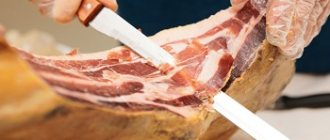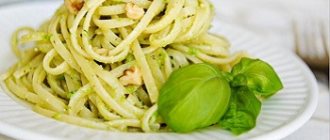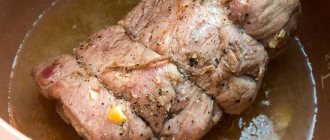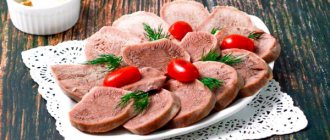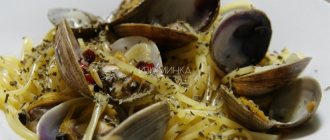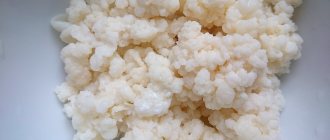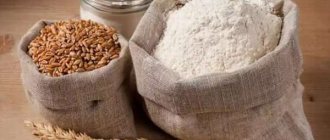Prosciutto is a favorite Italian ham in many countries. However, it has nothing in common with the ham that we are traditionally accustomed to seeing on the shelves of domestic stores.
Prosciutto is a cured pork ham that is sold whole or cut into thin slices. Manufacturers' loyalty to manufacturing traditions and centuries-old history have allowed Italian ham to easily join the ranks of DOP category products.
Varieties of DOP
In Italy, as many as 7 varieties of prosciutto are produced , classified as products with a protected designation of origin. To understand how all these options differ, we will introduce you to each of them.
Prosciutto di Parma
Prosciutto di Parma is the most famous type of ham produced in the province of Parma. It is prepared from just two ingredients: pork and salt. The use of other spices or preservatives is strictly prohibited.
The meat for Parma ham should not be frozen. The manufacturing process takes about a year. After quality control, the European Union Commission applies a stamp in the form of a crown (a distinctive feature of Prosciutto di Parma). The meat retains its natural red color due to the natural ripening process. The taste of ham is sweet, refined, intense.
Prosciutto di San Daniele
Prosciutto di San Daniele is a typical product of the city of San Daniele del Friuli. As they say in Italy, this ham contains 3 components: pork, sea salt and the unique climate of the territory.
The total production cycle of the recipe is 13 months. The hallmark of Prosciutto di San Daniele is the “paw” on the pork butt, meaning the thigh is left “biologically intact.” The meat is pink-red in color with white streaks of fat. The taste is sweet, delicate with a spicy aftertaste.
Prosciutto di Modena
Prosciutto di Modena is a ham traditionally produced in the city of Modena.
The unique set of geographical factors of the production area makes this product unique. Meat aging time is about 14 months or less (depending on thigh size) . The weight of the ham at the end of ripening is 8-10 kg. The cut color is bright red. The taste is rich, but not salty. Ham has a pleasant, sweet aroma.
Prosciutto Toscano
Prosciutto Toscano is a ham from the Tuscany region.
Salting of meat for this variety is carried out not only with salt, but also with pepper, as well as a mixture of herbs (sage, rosemary). Aging lasts from 10 to 12 months, but some specimens mature for about a year and a half. The weight of the ham must be at least 7.5 kg. The color is bright to light red with a slight presence of white fat. The taste is delicate with the aroma of herbs.
Prosciutto Veneto Berico-Euganeo
Prosciutto Veneto Berico-Euganeo is a ham from Montagnana.
It is made from pork thigh using salt and seasonings. Prosciutto Veneto has a distinctive mark in the form of a winged lion. The weight of the ham at the end of cooking is from 8 to 9 kg, aging for at least 9 months. The color of the meat is usually pink. The aroma is soft and sweet.
Prosciutto di Carpegna
Prosciutto di Carpegna is a ham from the city of Carpegna , the pork for which is produced in 3 regions of Italy: Emilia-Romagna, Marche and Lombardia. Salted hams are aged for at least 13 months. The final weight of the thigh is from 8 to 11 kg. The cut is salmon colored. The taste is delicate, the aroma is piercing.
Prosciutto crudo di Cuneo
Prosciutto crudo di Cuneo is a product produced in the provinces of Cuneo, Asti and the southern part of Turin.
Salting is done using dry salt, which may contain pepper or other spices. The overall production process lasts a minimum of 10 months. The weight of the finished ham is from 7 to 10 kg. The cut color is uniform, red. The aroma is seasoned and sweet.
To summarize, let us clarify the main differences between all varieties:
- Production area;
- Breed, age and food of animals;
- Spices for salting and holding time.
Based on these features, the unique taste of each ham is formed. But, despite the originality of all types, only prosciutto from Parma has special world fame. We will tell our story about him.
Guanciale
This type of prosciutto is produced in many regions of Italy and is labeled according to the region of origin.
Tuscany, Abruzzo, Umbria, Sardinia, Calabria, Friuli-Venezia, Lazio.
It is made from the throat of a pig's head and cheeks. "Guanciale" is translated as sheka.
First, it is salted in barrels along with spices, which are added in different regions according to their own recipe.
Then they are dried for two months. The meat turns out very flavorful.
The main purpose of guanciale is to prepare pasta carbonara (pasta alla carbonara) and amatriciana (al`amatriciana).
Guanciale
Story
Pork has been the main source of nutrition for the people of Parma for more than 2,000 years, so the history of Parma ham dates back to Roman times. Its production probably began with the development of the Salsomaggiore salt spring, when farmers learned to use the properties of salt to preserve meat.
There are several versions of the origin of the name “prosciutto”. According to one of them, the word is derived from the Parma dialect “pàr-sùt”, which means “always dry”. Another theory ascribes its Latin origin to the phrase Perex Suctum, which translates to “fused” or “dried.” Already in the 3rd century BC. Cato described the prosciutto production process, which has survived to this day almost unchanged. Then, over the centuries, many authors (Polybius, Strabo, Horace) mentioned ham in their works.
Hannibal, entering Parma after a victorious battle in 217 BC, was greeted with a festive banquet. Despite the devastation and poverty, the peasants pulled out salted meat from their hiding places, which the commander especially valued.
It is obvious that the French Gauls were also familiar with prosciutto di Parma. The entrance to Reims Cathedral in France depicts a butcher selling ham.
Despite such distant roots, mass production of prosciutto began only in the Middle Ages. It is mentioned in documents from the 14th century and in wedding menus from the 16th century. And at the turn of the XVIII-XIX centuries. ham was used as a staple food for sailors during the “cruising war.”
In order to protect the tradition and quality of their product, in 1963 Parma producers assembled a consortium to supervise the production of ham. And in 1996, the European Union included Prosciutto di Parma in the list of DOP products.
Use in Italian cooking
Prosciutto is an independent dish in itself . It can be used as an appetizer, served with green peas, asparagus, melon, and is included in various sauces, Italian pasta, and sandwiches.
Here, for example, is a simple recipe for a summer snack with prosciutto and melon, common in Italy:
Housewives from all countries actively use this type of ham to prepare all kinds of dishes. Let's look at some of them , which you can easily repeat at home.
Scrambled eggs with pesto
To prepare you will need the following ingredients:
- 20 g butter;
- 2 eggs;
- 100 ml 20% cream;
- 30 g prosciutto;
- teaspoon pesto;
- a pinch of salt.
Preparation:
- Heat the butter in a frying pan over low heat.
- Break the eggs into a bowl, beat them a little with a whisk, add cream and salt. Mix again and pour into the oil in the frying pan. Using a spatula, pull the edges of the scrambled egg towards the middle, then vigorously stir it. After 40 seconds, remove from heat and add pesto.
- Thinly slice the tomato and place it on a plate. Place a scrambled egg on top and slices of ham on top. Season with pepper.
Unusual salad with pear
Baked asparagus
For this interesting recipe you need to prepare the following:
- 20 pieces of fresh asparagus pods;
- 4 slices of Italian ham;
- 4 teaspoons olive oil;
- 60 g parmesan cheese;
- 4 chicken eggs;
- a tablespoon of thyme;
- ground black pepper - to taste.
Preparation:
- Place the pan over medium heat and heat a couple of teaspoons of oil in it. Add prosciutto and fry for a minute. Remove from heat and place on paper towels.
- Preheat the oven to 200 degrees, grease a baking sheet with oil. Toss the asparagus in the remaining oil and place it on a baking sheet, season with salt and pepper. Bake for 12 minutes until soft.
- Cut the cheese into thin slices, place it on top of the asparagus, and leave in the oven for another five minutes to melt. Divide among four plates and cover.
- Pour water to a level of 5 cm into the pan and place on fire. Add a teaspoon of salt, let it boil, then reduce the heat. Break the eggs into the water one at a time. Cook in slightly boiling water for 3-4 minutes until the yolk is ready. Remove the eggs and carefully place one at a time on top of the asparagus.
- Place prosciutto on plates, sprinkle with thyme, salt and pepper to taste.
How to cook pasta
Technological recipe
A prerequisite for obtaining Parma ham is that the entire process of preparation and processing of raw materials takes place in and around Parma. Pigs of 2 breeds (Large White Landrance and Duroc) are raised in 10 regions of central and northern Italy. Corn, barley and whey left over from the production of Parmigiano are used as food. The animal is only ready to enter the production cycle when it reaches the age of 9 months and weighs 160 kg.
Fresh meat “rests” in special refrigerated cells for 24 hours. At this time, it becomes more dense and loses approximately 1% of its weight. Ham ham should not be frozen.
Part of the skin and fat is cut off from the prepared thigh. This is necessary for subsequent salting. During this operation, the ham loses 24% of its weight. Instances that have even the slightest defects (cuts, bruises) are excluded from the cycle.
Salting occurs in this way: parts covered with skin are treated with wet salt; The exposed meat is sprinkled with dry. Next, the thighs are sent to refrigeration chambers with a temperature of 1-4 degrees and 80% humidity. After a week, they are taken out and the residual salt is removed. Then they re-sprinkle with a thin layer of salt and send the pork to the refrigerator for 15-18 days (depending on weight) for the so-called “second salting”. At this stage, the ham loses about 4% of its weight.
Salting is followed by “rest” of the future ham, which takes place after removing unabsorbed salt in refrigerated rooms at 1-5 degrees and 75% humidity and lasts 60-80 days. Weight loss during such “sleep” is 8-10%.
“Rested” thighs are thoroughly washed with warm water to remove the smallest salt crystals. Then they are dried in rooms with special air convection. Although on warm sunny days drying occurs naturally in well-ventilated rooms.
After preliminary drying, the pork is hung on frames in rooms with large windows for about 3 months. At this time, prosciutto di Parma acquires its characteristic taste and loses another 8-10% of its weight.
At the penultimate stage, the open part of the prosciutto is greased with a mixture of chopped lard with salt and pepper (sometimes rice flour is added). This helps tenderize the meat and prevent the ham from drying out too quickly.
Next, the seven-month-old pork is transferred to special cellars, where it matures for up to a year, absorbing the unique aroma of the Parma climate. There are varieties aged for 18, 22 and 24 months. The aroma of the ham is tested using needles made of a special material. They pierce the ham, and experts evaluate the characteristic smell. After complete inspection, the finished prosciutto di Parma is branded with the distinctive sign “crown with 5 teeth”.
A bone-in ham goes on sale weighing 9.5-10.5 kg. Prosciutto di Parma is a real cured ham, called prosciutto crudo in Italy. There are variants of prosciutto cotto on the European grocery market. This is a boiled ham, the meat for which does not come from the ham, so it is considered much less valuable. By the way, prosciutto cotto is a more familiar version of ham for domestic consumers.
Prosciutto from Norcia (Prosciutto di Norcia IGP)
To earn the right to the IGP designation, prosciutto di Norcia must be produced in the areas of the municipalities of Norcia, Cascia, Preci, Poggiodomo, Monteleone di Spoleto at an altitude of at least 500 meters above sea level. This precaution eliminates the possibility of coastal humid air masses influencing the ripening process of meat.
A large pork ham is salted with dry sea salt in two stages over 15-20 days. This is followed by a three-month “rest” period, at the end of which the meat is washed with warm water and dried for another three months. Thus, six months from the start of cooking, the time comes for processing with spices and applying a protective fat layer to the open cut of the ham. At 12 months, the prosciutto is inspected, marked, and the protective layer is renewed.
Photo taccuinistorici.it
Prosciutto from Norcia, along with its famous brothers, is considered a dietary product, useful for consumption at any age. Initially, high-quality meat prepared in this way retains a maximum of useful minerals and acquires the ability to be perfectly digestible.
How is it different from jamon?
Many people know that Italian prosciutto has a famous Spanish relative - jamon. Despite their great similarity, these products have a number of significant differences - what is the difference between prosciutto and jamon?:
- Place of production and climatic conditions of the territory, which significantly influence the taste.
- In Spain, animals are fed acorns, while in Italy the diet is based on corn and other grains.
- Thanks to the use of black pig breeds, jamon has a darker surface than prosciutto.
- Prosciutto is salted indoors, and jamon is salted in closed containers. This makes the Spanish product drier and tougher than Italian ham .
- Ham, unlike prosciutto, is aged for about 48 months. Therefore, the cost of such a delicacy is very high. The readiness of ham in Italy occurs on average within a year, which is why its price is much lower.
The Spaniards consider jamon to be the most delicious ham in the world, while Italians categorically disagree with this opinion. Which delicacy you choose will be entirely your personal decision.
Italian lard
Of course, calling this delicacy that way is rude and unfair. Prosciutto doesn't deserve that name. That this is a variety of bacon or ham is beyond doubt, but it is a very distinguished ham.
The history of prosciutto is lost in the darkness of centuries. It is certain that it already existed in the times of Ancient Rome, but since then it has greatly improved in taste. Some analogues exist among many nationalities: the Spaniards praise jamon, the French consider jambon the pinnacle of ham taste, but only the Italians have truly achieved perfection.
How to eat and store
Do you prefer natural products and appreciate the rich taste of dishes? Without a doubt, Prosciutto di Parma will become your favorite in the kitchen. It will add depth of flavor to any of your dishes.
In Italy, prosciutto is eaten on its own as part of a meat plate or wrapped around a grissini breadstick. Ham goes well with melon, grapes, Italian cheeses, olives, and figs. If you have your own preferences, then Parma prosciutto will perfectly complement the taste of any first or second course.
Salad with prosciutto is especially popular on the peninsula. It is quite simple to prepare. Mix chopped green salad, thin slices of ham and Parmesan cheese. All this is seasoned with a small amount of olive oil and you enjoy a tasty, healthy and fairly light dish.
Are you crazy about pizza? Undoubtedly, prosciutto pizza will satisfy any taste requirements. You will be surprised, but this dish does not have a single recipe. There are thousands of options on the Internet. This means that you can prepare prosciutto pizza like this:
- Roll out the dough into the required shape.
- Fill the base with your favorite ingredients (cheese, mushrooms, meat, vegetables, onions, etc.) place prosciutto on top, sprinkle with a little grated cheese.
- Bake the pizza in a preheated oven for about 15 minutes and enjoy the result.
And finally, about alcoholic drinks. Parma ham will be a wonderful aperitif with beer or wine (preferably white such as Malvasia dei Colli di Parma or Prosecco).
Often people are interested in a recipe for making prosciutto at home. There is nothing more complicated or simpler! But, if you have rooms with the required temperature and humidity, then everything is in your hands. Just follow the technological recipe, improvise with spices and after 7-12 months you will have your own ham.
How to store at home
Most prosciutto is sold in vacuum packaging, after opening which the question arises of how to store it. An improperly prepared product loses freshness and absorbs refrigerator odors. But there is still no clear solution.
Some experts suggest placing the cooked ham in a vacuum container, which is almost impossible at home, given its size. Others recommend wrapping the ham in a slightly dampened cloth.
The third and perhaps most reliable option is to cover the cut of the thigh with foil or plastic wrap. And, naturally, after the packaging you have chosen, the ham must be placed in the refrigerator.
Some masters claim that it is possible to store prosciutto without packaging. But over time, stains form on its surface, which are a mixture of water, salt and fat. They must be cut off before use.
Traditions of use
In Italy, according to the traditional recipe, it is customary to serve prosciutto with fried pork, vegetables or melon. It is an indispensable ingredient in classic tortellini . Pairs well with white wines.
To a large extent, the traditions of eating prosciutto are determined by the taste preferences of a particular region. However, you need to know that you should cut the ham only immediately before eating it - in this form it is not suitable for long-term storage. Even after an hour, the slice will lose most of its properties and become very dry.
If you still need to cut the dish in advance, then you should deviate slightly from the classic variation and make the slices thicker.
Calorie content and benefits
Prosciutto di Parma is a fairly light product. Its calorie content per 100 g is 269 kcal, which consists of:
- Protein 25.9 g;
- Fat 18.3 g;
- Carbohydrates 0.3 g.
We can talk endlessly about the nutritional value of prosciutto. This is an excellent source of proteins - the main building components of many substances and tissues of the body. The unique amino acid composition contributes to the easy bioavailability of ham proteins, which is indispensable for children, athletes and people who have problems digesting proteins.
The fat content of prosciutto is relatively high, but most of the lipids (45.8%) are unsaturated, the consumption of which is beneficial for humans. They prevent the development of cardiovascular diseases. Currently, manufacturers produce low-fat Parma ham so that not only healthy people can enjoy this wonderful product.
Prosciutto di Parma is characterized by a high content of B vitamins. Scientists have proven the significant presence of B1, B6, B12, PP. These substances play an important role in the functioning of the nervous system, in hematopoiesis, and control the redox reactions of the body.
Folic acid, also found in ham, is involved in many biological processes such as cell replication. Fat-soluble vitamin E is a natural antioxidant. It fights free radicals and regulates the function of the human reproductive system.
The nutritional value of prosciutto is enhanced by the presence of vital minerals. Zinc, copper and selenium (23%, 3%, 20% of the daily value of 100 g, respectively) are involved in the activity of the immune and cardiovascular systems and regulate cell division. Iron (6% DV) promotes hematopoiesis and is essential for people suffering from anemia. Potassium (27% DV) is responsible for the proper functioning of the heart and blood vessels, and phosphorus (26% DV) maintains healthy teeth and skin.
Thus, prosciutto di Parma is a unique, indispensable product in a healthy diet . Although people with high blood pressure, diabetes or excess weight are recommended to consume ham only in consultation with their doctor.
Manufacturing Features
Subtleties and tricks begin with the maintenance and fattening of cattle going to prosciutto. There is no doubt that this affects the taste of the final product. For any type of this ham, pigs are fattened with fruits and acorns, but in each prosciutto-producing province there are secrets even in the diet of the animals. One of the secrets revealed by Parma is that they feed the pigs there with the whey left over from the production of Parma cheese. As a result, the prosciutto of this province has a completely different taste from other areas.
The same goes for spices. If Parma makes do with sea salt exclusively, then in other places they use pepper and garlic, and in others - specially selected herbs.
Price per kg
Arriving in Italy, you can easily find original prosciutto in any grocery store. The price for all varieties of DOP ham is approximately the same and ranges from 25-27 Euros per 1 kg.
The food embargo works incredible miracles, so Russian counters are crying, missing prosciutto. The average price of Italian ham in domestic stores previously varied between 2000-2500 rubles. for 1 kg.
The topic of “Prosciutto” is inexhaustible, but the conversation smoothly came to an end. If you want to feel the entire gastronomy of Italy in one product, spend your holidays in the republic, enjoying prosciutto and the beauty of the country.
Live openly, love freshly, travel with inspiration and remember: “Put a pig at the table, he will put his feet on the table. And why not, if it’s prosciutto!”
